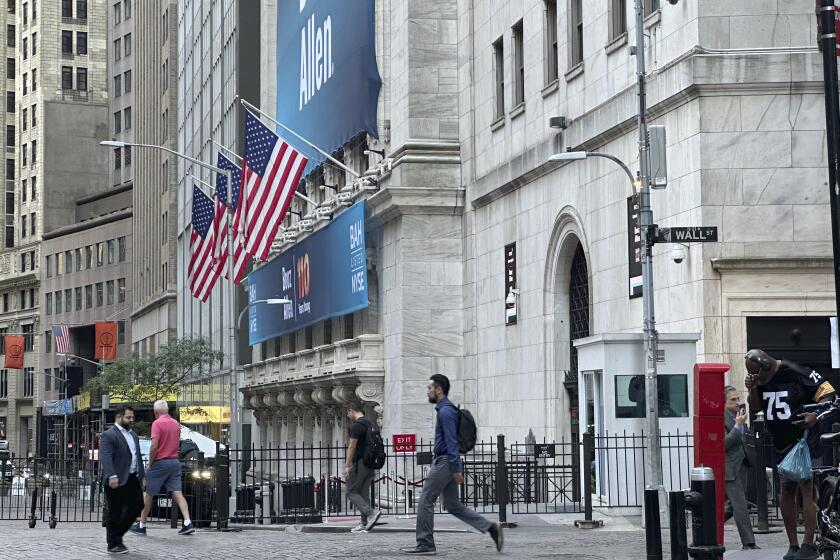IBM Reports First Loss--$2.8 Billion : Business: The 1991 decline is blamed on the recession and costs of staff reductions. The firm’s stock has fallen, but analysts believe it will weather the storm.
- Share via
Reflecting tough times for large U.S. companies in general and for the computer industry in particular, International Business Machines Corp. on Friday reported a $1.4-billion fourth-quarter loss, contributing to the first annual loss in the firm’s 80-year history.
The $2.8-billion loss for all of 1991 recorded by the world’s largest computer company--which for more than half a century has represented both America’s technological leadership and its marketing might around the world--is one of the largest yearly losses ever posted by a U.S. business.
The setback reflects burdens hitting many of America’s corporate giants--the costs of shedding tens of thousands of employees and providing for their health care, while sales are slowed by the lingering recession.
IBM’s poor performance also reflects its struggle to deal with a fundamentally changed computer market, one moving away from the company’s stronghold in large, centralized mainframe computers and toward smaller desktop computers, an area where nimbler competitors have stymied the giant firm.
Digital Equipment Corp., IBM’s biggest competitor and also a maker of large computer systems, reported a $138-million loss in the last quarter.
Last year “was a disappointing year,” IBM Chairman John F. Akers said. “We were adversely affected by protracted worldwide economic weakness, competitive pressures and transitions within our product lines.”
However, analysts said, IBM has sufficient resources to weather such a large loss, although its stock price has declined precipitously and critics say it is not doing enough to cut costs and stem its woes. The underlying business of the computer maker also was weaker than many analysts predicted.
Most IBM-watchers are not ready to say it will go the way of the American auto industry, but they say it shares with General Motors Corp. and Chrysler Corp. the disadvantage of a large, bureaucratic and entrenched corporate culture.
“IBM is a large company wrestling with the problems of its huge size and its cultural heritage and being unable to move fast in a rapidly changing market. The Japanese are breathing down its neck in some sectors,” said Ulric Weil of Weil & Associates, a Washington consulting firm dealing with high technology.
The loss, which was expected, resulted in part from $3.4 billion spent on early retirement benefits and other costs of slimming IBM’s staff by 29,000 people last year. The company also wrote off $2.3 billion to account for costs of future retiree health benefits.
Aside from these costs, IBM’s core business of selling computers recorded a meager profit of $942 million, down 92% from $11 billion last year. Its 1991 revenues of $64.8 billion worldwide were down 6%, its first annual sales decline since 1946.
For IBM’s 345,000 employees worldwide, the loss marked the end of a dismal year. In 1991, continuing staff reductions and a major organizational shake-up aimed at invigorating the firm’s infamous bureaucracy shocked what had been one of the world’s most stable corporate cultures.
IBM’s problems prompted it to take unusual actions last year. In July, it announced a startling alliance with competitor Apple Computer Inc. to develop advanced personal computers and software. In December, IBM announced a plan to make its business units more independent.
Meanwhile, analysts and some shareholders were clamoring for even faster staff cutbacks, saying the company had been too kind in avoiding out-and-out layoffs.
IBM’s management “thinks they are being merciful and generous by not (cutting people) until the water is up to their nostrils . . . but they are deluding themselves by saying we’ll get over these problems in a few years,” Weil said.
For investors, including many small shareholders who had bought IBM stock believing it was a safe investment, the announcement put the final nail into the coffin of the company’s image as the bluest of blue chips.
Investors who bought IBM for $176 per share at its peak in 1987 have watched it lose nearly half its value. On Friday, IBM’s shares closed at $96.375 per share, up 87.5 cents for the day but well below last year’s high of $139.
“You can’t put your money in and forget about it. Technology has always been a volatile investment,” said Philip Rueppel, an analyst at the investment firm of Sanford C. Bernstein.
IBM still dominates much of the computer industry, and its sales, about half of which are overseas, remain five times larger than its nearest competitor, Digital Equipment. But it has faltered in the growing market for desktop computers, which, when linked into networks, are replacing many mainframes, IBM’s greatest strength.
“IBM’s feet are stuck in the mainframe mud,” Weil said.
But other analysts say that reports of the mainframe’s death are greatly exaggerated, and they note that sales of IBM’s newest mainframe line, released in September, have been strong. In fact, slow sales in the first three quarters of this year were in part due to customers waiting for the new models, which had been announced a year earlier.
Analysts agree that things should look up for IBM in 1992, driven by increasing demand for mainframes. Bob Djurdjevic, president of Annex Research in Phoenix, estimates that revenues should grow 7% to 10% this year, and profits should recover as well. But he is also counting on another $1 billion or so in costs for continuing restructuring.
IBM says it plans to cut another 15,000 to 20,000 jobs this year, even though 9,000 more employees than expected took early retirement in 1991. IBM-watchers say they are happy to see the slimming but are worried that some of the company’s most talented employees may be the ones leaving.
Analysts are also skeptical about how soon IBM’s tie-up with its once-fierce competitor, Apple Computer, will bear fruit.



